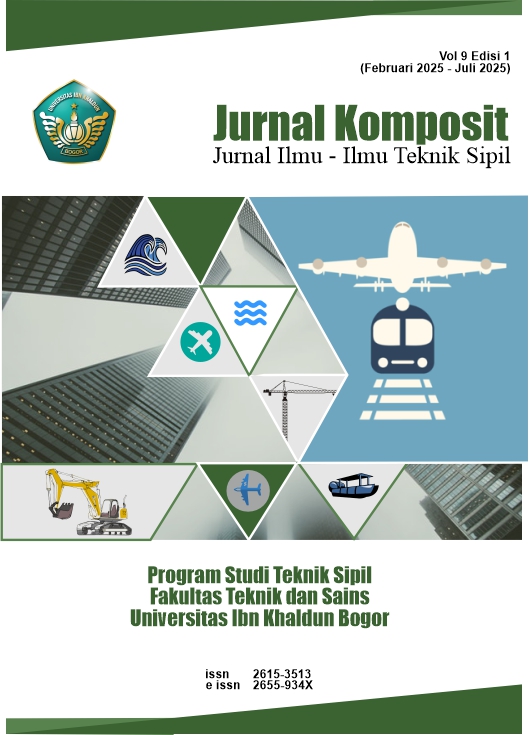Implementasi Building Information Modelling (BIM) 5D pada Pekerjaan Kost 2 Lantai Tipe 600
DOI:
https://doi.org/10.32832/komposit.v9i1.17318Keywords:
Building Information Modelling (BIM), Volume, 5D, CostAbstract
Technological advances in the world of construction have brought many benefits, especially in building pomodeling, scheduling, cost estimation, volume changes, building continuity, and building management. A widely used technology is Building Information Modeling (BIM). Accurately estimating construction costs is essential to obtain efficient values during planning. In calculating the cost of construction projects, conventional methods are still often used, resulting in increased costs. Therefore, this research will use the concept of Building Information Modeling (BIM) 5D which aims to analyze the volume and cost estimates, as well as analyze the difference in volume and cost between the BIM method and the Consultant's calculations on the structural work of the construction of the 2-storey boarding house Sepinggan Baru 1. The results showed that the structural work of the construction of the 2-storey boarding house Sepinggan Baru 1 with the Bim 5D concept had a volume of ironwork of 23305.48 kg at a cost of Rp 421.992.326,4, and a concrete volume of 109.05 at a cost of Rp 215,386,847.00. The difference in iron volume is 17,3% while the difference in concrete volume is 0.84%. This means that the calculation using the 5D Building Information Modeling (BIM) concept with the help of Autodesk Revit Software is lower than the cost planning produced by the consultant.
References
Fitriono, F., Haza, Z. F., & Shulhan, M. A. (2023). Analisis Perbandingan Rencana Anggaran Biaya (RAB) Metode Konvensional dengan Metode Building Information Modeling (BIM) (Studi Kasus Gedung 3 Lantai di Yogyakarta). Jurnal Ilmu Teknik Sipil Surya Beton, 7(1), 13–24. DOI:https://doi.org/10.37729/suryabeton.v7i1.3031
Gunawan, M., & Kartika, N. (2021). Penerapan Building Information Modelling (BIM) pada Proyek Pasar Soreang Kabupaten Bandung. Jurnal Student Teknik Sipil, 3(2). https://doi.org/10.37150/jsts.v3i2.1655
Joko, T. (2018). Rencana Anggaran Biaya (RAB). Badan Pengembangan Sumber Daya Manusia, Kementrian Pekerjaan Umum Dan Perumahan Rakyat. https://www.slideshare.net/slideshow/2613b0bahanpelatihanmenyusunrabkendaripdf/255840355
Laorent, D., Nugraha, P., & Budiman, J. (2019). Analisa Quantity Take-Off Dengan Menggunakan Autodesk Revit. Dimensi Utama Teknik Sipil, 6(1), 1–8. https://doi.org/10.9744/duts.6.1.1-8
Barrung, J. D., & Napitupulu, K. J. H. (2022). Implementasi Building Information Modeling Direktorat Preservasi Jalan Dan Jembatan Wilayah II. Prosiding KRTJ HPJI, 1-12. https://id.scribd.com/document/637211230/141-Implementasi-Building-Information-Modeling-Direktorat-Preservasi-Jalan-dan-Jembatan-Wilayah-II-Jeffry-Daud-Barrung-icha-giani-1
Putra, Z. Z. D., Danuarta, F., Pratiwi, R., & Hendriyani, I. (2024). Analisis Pekerjaan Beton Bertulang dengan Building Information Modelling (BIM) 5D pada Proyek Pembangunan Kantor dan Pos Jaga Depot Supply Point Pertamina Lubricants Tarakan. Jurnal Komposit: Jurnal Ilmu-Ilmu Teknik Sipil, 8(2), 271–278. https://doi.org/10.32832/komposit.v8i2.15893
Pratama, R. (2021). LKP Proyek Pembangunan Living Plaza Medan. Universitas Medan Area. https://repositori.uma.ac.id/jspui/bitstream/123456789/18479/1/198110179%20-%20Rizky%20Pratama%20-%20LKP.pdf
Ramadhani, F. (2023). Implementasi BIM Pada Tahap Pelaksanaan Konstruksi Dengan Common Data Environment (CDE) (Studi Kasus: Proyek Gedung Universitas Nahdatul Ulama Yogyakarta). https://dspace.uii.ac.id/handle/123456789/43441
Riyadi, S., Taqwa, F. M. L., Brillianto, A. G., & Simanjuntak, M. R. A. (2024). Analisis Implementasi Teknologi Building Information Modelling (BIM) pada Tahap Perencanaan Bangunan Gedung Istana Kepresidenan Ibu Kota Nusantara (Studi Kasus PT Yodya Karya, Persero). Jurnal Komposit: Jurnal Ilmu-Ilmu Teknik Sipil, 8(2), 279–288. https://doi.org/10.32832/komposit.v8i2.15450
Rokooei, S. (2015). Building Information Modeling in Project Management: Necessities, Challenges and Outcomes. Procedia - Social and Behavioral Sciences, 210(February), 87–95. https://doi.org/10.1016/j.sbspro.2015.11.332
Situmorang, B. E., Arsjad, T. T., & Tjakra, J. (2018). Analisis Risiko Pelaksanaan Pembangunan Proyek Konstruksi Bangunan Gedung. Tekno, 16(69), 31–36. DOI: https://doi.org/10.35793/jts.v16i69.20891
Qodiron, L., Oktarina, D., & Fadilasari, D. (2023). Penerapan Sketchup dalam Perhitungan Rencana Anggaran Biaya sebagai Pendekatan BIM pada Pembangunan Rumah Tipe 45 . Jurnal Komposit: Jurnal Ilmu-Ilmu Teknik Sipil, 7(2), 173–181. https://doi.org/10.32832/komposit.v7i2.14253
Surokim. (2016). Riset Komunikasi : Buku Pendamping Bimbingan Skripsi. Pusat Kajian Komunikasi Publik Prodi Ilmu Komunikasi FISIB-UTM & Aspikom Jawa Timur, 285. http://komunikasi.trunojoyo.ac.id/wp-content/uploads/2016/01/BUKU-RISET-KOMUNIKASI-JADI.pdf
Pratiwi, R., Devi, S. M., Indriani, A. M., & Sari, H. M. (2022). Optimasi Waktu Dan Biaya Dengan Metode Time Cost Trade Off (TCTO) Pada Proyek Penambahan Bangunan Pasar Rakyat. Jurnal Ilmiah Teknik Sipil Transukma, 4(2), 93-105. DOI: https://doi.org/10.36277/transukma.v4i2.134
Waas, L., & Enjellina. (2022). Review of BIM-Based Software in Architectural Design: Graphisoft Archicad VS Autodesk Revit. Journal of Artificial Intelligence in Architecture, 1(2), 14–22. https://doi.org/10.24002/jarina.v1i2.6016
Downloads
Published
How to Cite
Issue
Section
License
Copyright (c) 2025 Jurnal Komposit: Jurnal Ilmu-ilmu Teknik Sipil

This work is licensed under a Creative Commons Attribution-NonCommercial-ShareAlike 4.0 International License.
Authors who publish with this journal agree to the following terms (Penulis yang mengajukan publikasi artikel telah menyetujui hal berikut):
- Through this publication, the author agree to submit the copyright of article writing to Jurnal Komposit: Jurnal Ilmu-ilmu Teknik Sipil. This copyright submission takes the form of, but is not limited to: reproduction of the article and parts therein, including photographic reproductions; distribution of articles through printed and electronic documents; and translation of articles(Bahwa melalui publikasi ini, hak cipta penulisan artikel diserahkan kepada Jurnal Komposit: Jurnal Ilmu-ilmu Teknik Sipil. Penyerahan hak cipta ini berupa, namun tidak terbatas pada: perbanyakan artikel dan bagian di dalamnya, termasuk reproduksi fotografi; penyebarluasan artikel melalui dokumen cetak dan elektronik; serta penterjemahan artikel).
- The authors agree to the terms of the Copyright Notice, according to Creative Commons Attribution-NonCommercial-ShareAlike 4.0 International License., which will apply to this article if and when it is published by Jurnal Komposit: Jurnal Ilmu-ilmu Teknik Sipil. (Para penulis setuju dengan ketentuan Pemberitahuan Hak Cipta, sesuai dengan Lisensi Internasional Creative Commons Attribution-NonCommercial-ShareAlike 4.0., yang akan berlaku untuk artikel ini jika dan ketika diterbitkan oleh Jurnal Komposit: Jurnal Ilmu-ilmu Teknik Sipil).

This work is licensed under a Creative Commons Attribution-NonCommercial-ShareAlike 4.0 International License.



.png)










